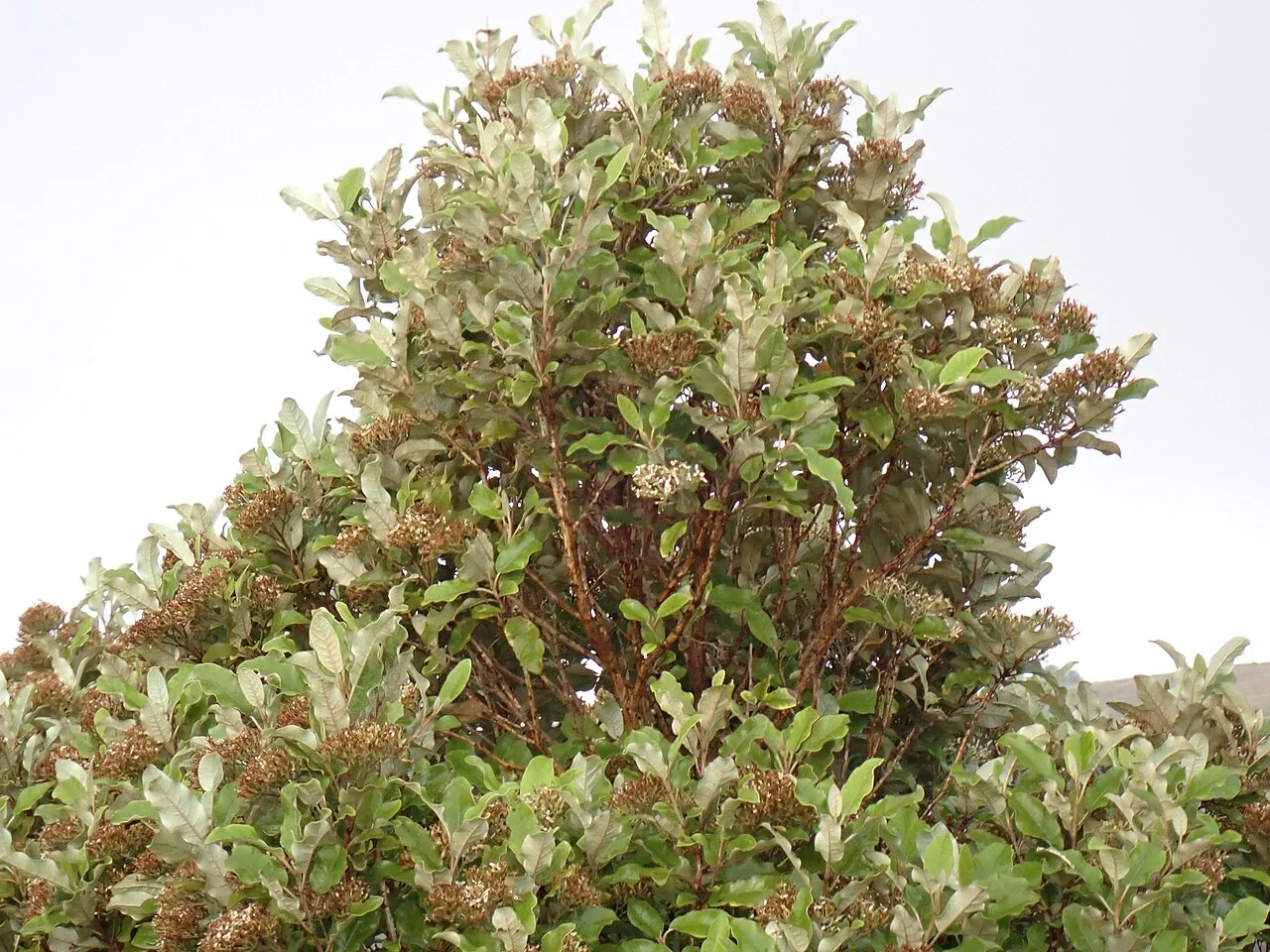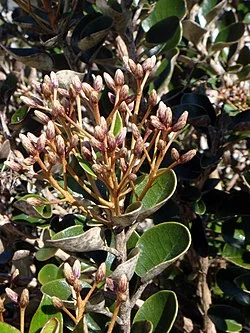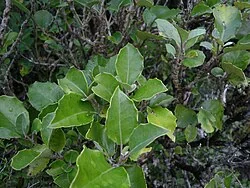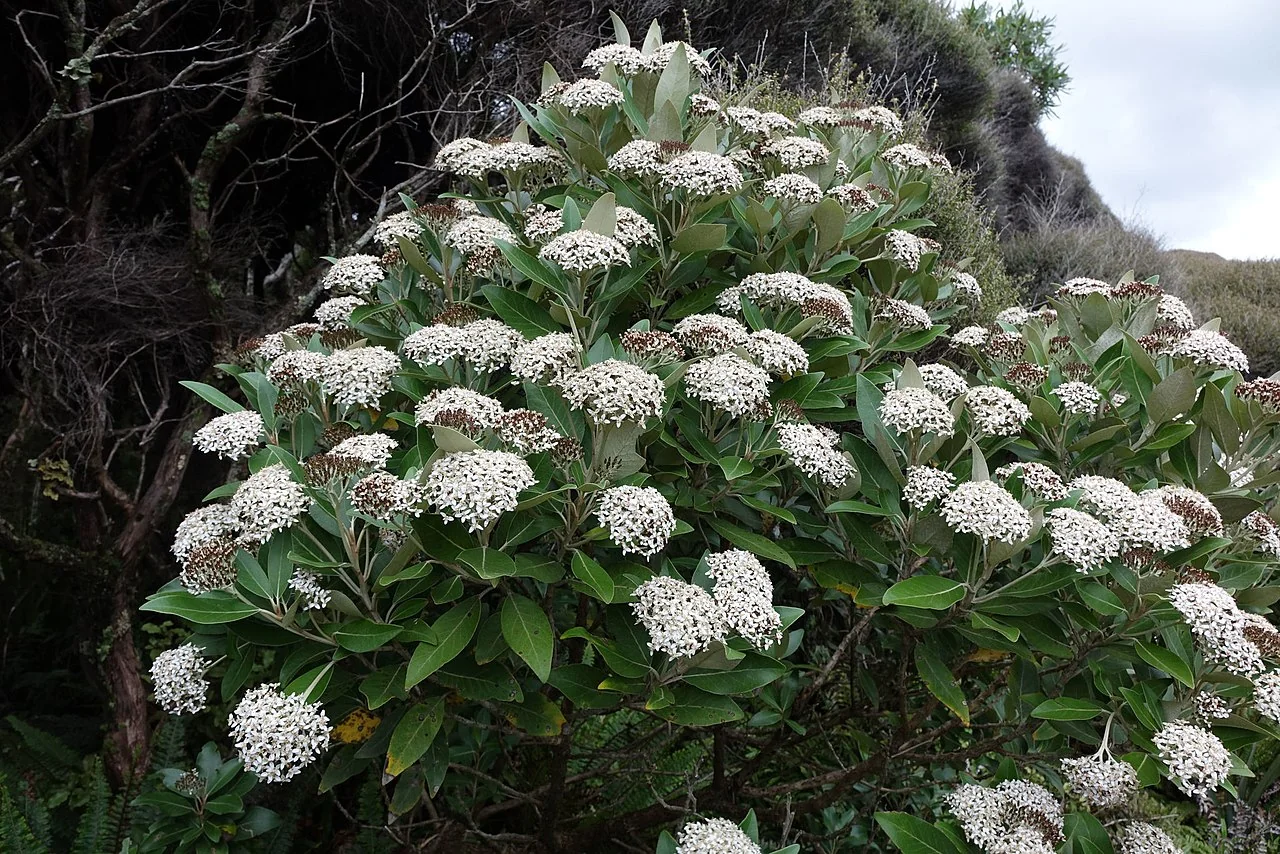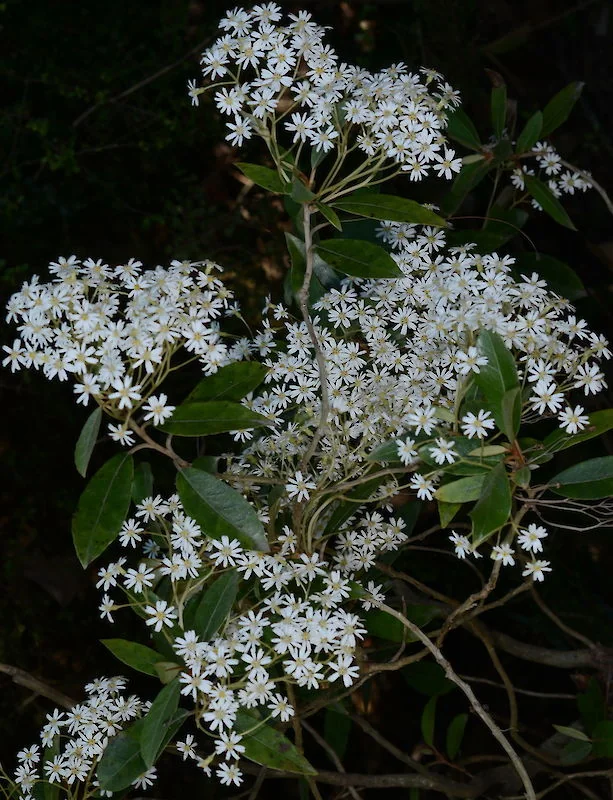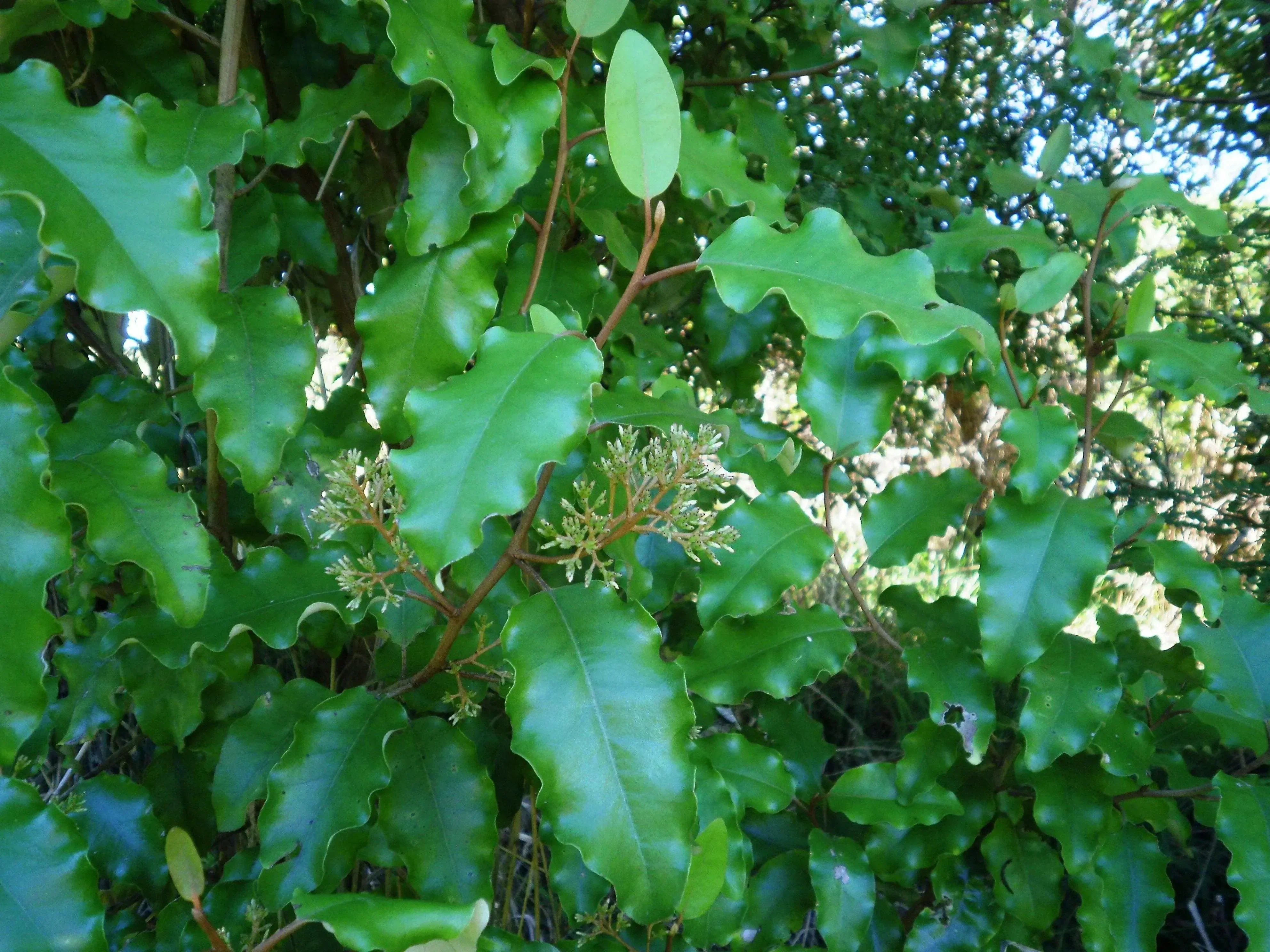
Hector's Tree Daisy
Olearia hectorii
Hector's Tree Daisy (scientific name: Olearia hectorii ) Hector's Tree Daisy is a native tree daisy that produces masses of small white or cream flowers. Like other Olearia species, it's valued for its hardy nature and ability to provide shelter and nectar for native wildlife. Explore more in the native plants index .

Plant Description
Botanical Features
Hector's Tree Daisy ( Olearia hectorii ), also known as deciduous tree daisy, is a nationally endangered species endemic to New Zealand's South Island. It is one of the few deciduous trees native to New Zealand, growing up to 10 meters tall with a spreading canopy. The trunk can reach up to 1 meter in diameter and is covered in thick, somewhat corky, grey bark that is deeply marked with longitudinal furrows. Branches are often spreading, and the slender branchlets are grooved, with bark that is red, red-brown, or bronze-red. Young branchlets may have four ribs, giving them a squarish cross-section. The leaves are arranged in clusters of opposite pairs. They are thin, pale moss-green to grey-green, roughly oval to narrow-oblong or oblong-ovate, and measure 20-50 mm long by 5-20 mm wide. The undersides are covered in a silvery tomentum (dense hairs), while the upper surface is glabrescent (becoming hairless). Small, pale yellow flowers are borne in clusters of two to six, typically appearing between October and early December, sometimes before the new leaves emerge. These flower heads are about 5x5 mm, with slender, silky-hairy pedicels (stalks) up to 15 mm long. The seeds are fuzzy and wind-dispersed.
Quick Facts
Overview
Olearia hectorii is a nationally endangered deciduous tree daisy endemic to the South Island, known for its corky bark and supporting numerous endemic moth species. It is a critical species for biodiversity conservation.
| Scientific Name | Olearia Hectorii |
|---|---|
| Height | 2-6 m |
| Spread | 2-4 m |
| Water Needs | Low to moderate |
| Light | Full sun to partial shade |
| Frost Tolerance | Moderate to good |
| Salt Tolerance | Moderate |
| Growth Rate | Moderate |
| Lifespan | Long-lived |
Climate Best Suited to
Regional climate suitability across major New Zealand cities.
Regional Suitability
| Whangārei | Ideal |
| Auckland | Ideal |
| Hamilton | Suitable |
| Rotorua | Suitable |
| Tauranga | Ideal |
| Gisborne | Ideal |
| New Plymouth | Ideal |
| Whanganui | Ideal |
| Palmerston North | Suitable |
| Napier | Ideal |
| Wellington | Ideal |
| Nelson | Ideal |
| Christchurch | Suitable |
| Dunedin | Suitable |
| Invercargill | Suitable |
| City | Climate Suitability |
|---|
Natural Habitat
Hector's Tree Daisy is endemic to the South Island of New Zealand, primarily inhabiting wet, cold valley floors and hill slopes, often where mountain and hill-country streams discharge onto the plains. It can also be found as a riparian and forest margin species in some lowland areas, favoring open sites that are or were canopy gaps in primary forest margins and streamsides. It relies on natural disturbances like flooding, sedimentation, and erosion to create suitable seeding sites.
Conservation
Conservation Status
Olearia hectorii , also known as Hector's tree daisy, is a critically endangered deciduous native tree found exclusively in the South Island of New Zealand. Its total population is estimated to be around 4,500 individuals across approximately 90 sites. The primary threats to Olearia hectorii include: habitat loss and fragmentation due to human activities, lack of seedling recruitment, as its seeds require open, disturbed ground for germination, which is often outcompeted by weeds and pasture plants, animal browsing by introduced mammals, aging populations with a significant number of old, non-reproducing trees, and limited protection, as most existing populations are located on private property rather than conservation land. Conservation efforts are underway, primarily led by New Zealand's Department of Conservation (DOC), which has a recovery plan for small-leaved tree daisies, including Olearia hectorii . The plan aims to secure viable populations by controlling threats, providing physical and legal protection, improving habitat, and enhancing existing populations. Key actions include raising public awareness, encouraging landowners to protect the species on their property, and promoting the use of locally sourced plants in revegetation projects. The plant is also significant for biodiversity, supporting at least 23 species of endemic moths, with 12 species exclusively dependent on it.
Growing Requirements
Soil Requirements
Occurs naturally on alluvial terraces; prefers free-draining, fertile loams with reliable moisture and no prolonged waterlogging.
Light Requirements
Full sun to light shade with shelter from severe winds.
Water Requirements
Consistent moisture during establishment; moderate thereafter.
Planting Guide
Site Selection
- Light: Hector's Tree Daisy thrives in full sun to partial shade, with open sites preferred for optimal growth. Young plants may benefit from some protection, while mature trees are very tolerant of exposure.
- Soil: This species has specific soil needs, preferring well-draining alluvial or colluvial soils. It tolerates gravelly and rocky substrates and adapts to periodically disturbed sites. Avoid heavily fertilized or constantly moist soils.
- Climate: It is naturally found in lowland to subalpine zones of the eastern South Island and is very hardy to frost. It thrives in areas with natural disturbance patterns like flooding, frost, and drought.
When to Plant
The best time to plant Olearia hectorii is in spring when soil temperatures warm and new growth begins. Autumn planting is also possible, but spring offers a longer growing season for establishment.
Ecological Role
Hector-s tree daisy ( Olearia hectorii ) is a threatened shrub-tree that adds structure and insect resources to dry eastern lowland remnants.
Pollinators and Seed
- Nectar/pollen: Composite heads feed native pollinators across fragmented habitats.
- Wind dispersal: Achenes travel to open microsites, supporting outpost recruitment.
Habitat Services
- Refuge: Divaricating form provides shelter from wind and browsing at the understorey.
- Erosion control: Roots stabilise dry, alluvial soils along river terraces.
By sustaining pollinators and binding soils, O. hectorii is pivotal to dryland biodiversity recovery.
Uses and Significance
Practical Applications
As a nationally threatened riparian tree daisy, Olearia hectorii is of immense conservation significance. Its primary "use" is in ecological restoration; prioritizing planting in protected sites is crucial to bolster regional populations and support the unique endemic moths that depend on its flowers for sustenance.
Cultural Significance
Traditional Uses and Values
Olearia hectorii , also known as Hector's Tree Daisy, holds cultural associations within Aotearoa (New Zealand), primarily through its broader genus, Olearia. While specific cultural uses directly attributed to Olearia hectorii are not extensively detailed, the Olearia species were valued by Māori for their practical applications.
The strong, dense wood of larger Olearia species, such as akeake, was utilized for crafting tool handles, weapons, and construction materials. The name "akeake" itself signifies the wood's hardness and durability, making it a prized resource for items requiring strength, like fence posts and various implements. Additionally, some Olearia species were used in traditional medicines, with specific applications varying among different iwi (tribes) and regions.
Beyond these general cultural uses, Olearia hectorii is recognized for its significant ecological value and is considered important in restoration efforts and gardens for its ecological services. It is a critically endangered native tree, crucial for biodiversity, as it supports at least 23 species of endemic moths, with 12 of these moth species exclusively dependent on it. This ecological importance contributes to its contemporary cultural significance in conservation and environmental stewardship in New Zealand.
Landscaping Ideas
Hector's Tree Daisy ( Olearia hectorii ) represents one of New Zealand's most critically important conservation landscaping opportunities. As a Nationally Endangered species with only approximately 4,500 individuals remaining, mostly on private property, every planting contributes directly to species survival and ecosystem restoration. This remarkable deciduous native tree offers unique landscaping possibilities while supporting conservation efforts and endemic biodiversity.
Conservation and Restoration Landscaping
- Species recovery projects: Partner with local conservation groups and DOC to participate in official recovery plan initiatives. Planting Hector's Tree Daisy in suitable locations contributes to securing viable populations across its natural distribution range.
- Riparian restoration: Excellent for stream-side and wetland edge plantings where it naturally occurs. Root systems help stabilize banks while providing habitat for endemic moths and other native species that depend on this host plant.
- Endemic biodiversity support: This species exclusively hosts at least 12 endemic moth species, with 23 species in total depending on it. Planting creates critical habitat for these threatened invertebrates found nowhere else in the world.
- Genetic diversity preservation: Use locally sourced plants from known provenance to maintain genetic diversity within populations. Each garden planting helps preserve unique genetic material for future generations.
Specialized Garden Applications
- Educational demonstration gardens: Ideal centerpiece for native plant gardens, botanical collections, and educational facilities where its conservation story can inspire others to participate in species recovery.
- Rare plant collections: Prized addition to specialist native plant gardens and collections, representing one of New Zealand's few deciduous native trees with distinctive corky bark and unique flowering habit.
- Seasonal interest gardens: Provides exceptional seasonal variation with spring flowering before leaf emergence, summer foliage development, and autumn leaf drop - rare characteristics among New Zealand natives.
- Heritage landscape restoration: Perfect for reconstructing historical South Island lowland and subalpine landscapes, particularly in Canterbury and Otago regions where it naturally occurred.
Practical Landscape Integration
- Shelterbelts and windbreaks: Effective component of mixed native shelterbelts, particularly valuable in rural properties where it can naturalize and potentially establish self-sustaining populations.
- Erosion control plantings: Naturally adapted to alluvial and colluvial sites, making it excellent for stabilizing slopes, stream banks, and areas subject to periodic flooding or soil movement.
- Wildlife corridor development: Essential component of wildlife corridors connecting fragmented habitats, providing both moth habitat and pollinator resources in landscape-scale conservation efforts.
- Specimen tree planting: Striking individual specimens for larger properties, parks, and public spaces where its unique characteristics and conservation significance can be appreciated and protected.
Cultivation Considerations for Conservation Success
- Site preparation: Ensure open planting sites free from competing grasses and weeds, as natural regeneration requires bare ground for successful seed germination. Remove introduced vegetation that prevents natural recruitment.
- Protection requirements: Young plants need protection from browsing animals (rabbits, possums, stock) that prevent natural regeneration in wild populations. Install appropriate fencing or guards during establishment.
- Water management: Plant in naturally moist but well-draining locations that mimic native habitat conditions - valley floors, stream terraces, or areas with seasonal water flow.
- Long-term stewardship: Commit to ongoing care and monitoring, as this species represents a significant conservation investment. Document growth, flowering, and any natural regeneration to contribute to scientific understanding.
Collaborative Conservation Impact
- Community involvement: Participate in local conservation groups, native plant societies, and citizen science projects focused on rare tree daisy recovery. Share propagation success and growing techniques with other gardeners.
- Specialist nursery support: Source plants from specialist native nurseries committed to conservation outcomes, ensuring proper provenance and supporting commercial conservation efforts.
- Monitoring and reporting: Contribute to species monitoring by documenting planted specimens, growth rates, flowering success, and any natural regeneration to assist ongoing recovery efforts.
- Education and advocacy: Use plantings as opportunities to educate others about New Zealand's endangered flora and the critical role private landowners play in species conservation.
Seasonal Care Calendar
Spring
Plant and stake; control weeds and browse.
Summer
Maintain moisture; protect from stock and rabbits.
Autumn
Mulch; light shaping.
Winter
Sanitation pruning on fine days.
Pruning and Maintenance
Techniques and Timing
Hector's tree daisy requires minimal intervention due to its threatened conservation status and natural growth pattern as one of New Zealand's few deciduous native trees. Focus maintenance on sanitation pruning during fine winter days, removing deadwood and crossing branches that may harbour disease. Avoid heavy pruning that could stress this vulnerable species. Protection from browsing animals and weed competition around the base is more critical than pruning for the survival of this nationally endangered tree.
How to Grow Hector's Tree Daisy
Hector's Tree Daisy is a critically endangered deciduous native tree that supports endemic moths and requires urgent conservation. This unique species is characterized by its distinctive corky bark and small yellow flowers. It is highly valued for its ecological importance and its role in supporting native biodiversity. Understanding its propagation methods is key to successfully growing this important species and contributing to its conservation.
From Cuttings
Semi-hardwood cuttings can be taken, though strike rates are variable for this threatened species. Best results are obtained from cuttings taken after leaf fall in autumn and kept in a cold frame over winter. Use rooting hormone and maintain consistent humidity. This method is crucial for conservation efforts as it preserves the genetic material of specific populations of this nationally endangered tree. Due to the species' rarity, it is recommended that propagation from cuttings be undertaken by experienced propagators or in specialized nurseries.
From Seed
Fresh seed offers the best viability for Olearia hectorii propagation. Surface-sow fine seed on well-draining mix, as seeds require open sites to germinate successfully. Protect emerging seedlings from frost and browsing animals, as recruitment failure is a major threat to wild populations. Provide weed-free conditions as competition from introduced grasses and herbs prevents natural regeneration in the wild. Seed collection should be done responsibly from healthy, wild populations or from cultivated plants of known provenance to ensure genetic diversity.
Pests and Diseases
Hector's Tree Daisy ( Olearia hectorii ) faces numerous serious threats that have contributed to its Nationally Endangered conservation status. As one of New Zealand's most critically threatened native trees, understanding and managing these challenges is essential for successful cultivation and species recovery efforts.
Critical Conservation Threats
- Browsing damage: Introduced grazing animals pose a severe threat to both wild and cultivated populations. Rabbits, possums, goats, and livestock prevent natural regeneration and damage existing trees. Protection with fencing or guards is essential for plant survival.
- Habitat degradation: Loss of suitable habitat through land conversion, development, and agricultural intensification has dramatically reduced available growing sites. Most remaining populations exist on private property with limited protection.
- Weed invasion: Aggressive introduced grasses and herbs compete directly with seeds and seedlings, preventing natural regeneration. This species requires bare ground for successful germination, which is increasingly scarce due to weed invasion.
- Reproductive failure: Isolated plants produce little viable seed, and recruitment is virtually absent in Canterbury, Otago, and Southland regions. Fragmented populations cannot maintain viable reproductive cycles.
Environmental Stress Factors
- Climate and disturbance changes: Historical flooding and natural disturbances that created regeneration sites are now often threats themselves due to changed land use patterns. The dynamic habitats it requires are increasingly disrupted.
- Competition pressure: Lack of natural disturbance means existing sites become dominated by competing vegetation, eliminating the open microsites essential for seed germination and seedling establishment.
- Genetic isolation: Small, fragmented populations face reduced genetic diversity and inbreeding depression, leading to decreased vigor and reproductive success in remaining trees.
- Limited pollination: As populations decline, reduced pollinator services affect seed production. The 23 endemic moth species that depend on this plant also contribute to its pollination, creating interconnected conservation challenges.
Cultivation-Specific Challenges
- Propagation difficulties: Variable success rates with both seed and cutting propagation. Semi-hardwood cuttings taken after leaf fall show best results, but require specialized cold frame treatment over winter.
- Establishment stress: Young plants are particularly vulnerable to environmental stresses, browsing damage, and competition. Extended establishment periods require careful monitoring and protection.
- Site requirements: Highly specific habitat needs for alluvial or colluvial soils with particular moisture and disturbance regimes make site selection critical for cultivation success.
- Seasonal vulnerabilities: As a deciduous species, plants are vulnerable to damage during dormant periods and require protection from stock and wildlife throughout the year.
Disease Prevention and Plant Health
- Stress-related diseases: Plants weakened by environmental stress, competition, or browsing damage become susceptible to secondary fungal infections and root rot problems.
- Wound management: Browsing damage and mechanical injury can lead to infection entry points. Maintain clean cuts during any pruning and protect plants from animal damage.
- Cultural disease prevention: Ensure excellent drainage as waterlogged conditions can lead to root problems. Avoid overfertilisation which may attract pests and reduce drought tolerance.
- Integrated pest management: Focus on habitat management and physical barriers rather than pesticides, as this species hosts numerous endemic moth species that require protection.
Conservation Management Strategies
- Physical protection: Install appropriate fencing to exclude browsing animals. Young plants require protection until well-established, often several years in conservation settings.
- Weed control: Maintain weed-free zones around planted specimens and clear competing vegetation to create suitable regeneration sites. Regular monitoring and removal of invasive species is essential.
- Habitat enhancement: Create or maintain open microsites for natural regeneration. This may involve periodic soil disturbance or vegetation management to mimic natural conditions.
- Population supplementation: Work with conservation groups to enhance existing wild populations through careful supplementary planting using locally sourced genetic material.
Recovery Plan Integration
- Collaborative monitoring: Participate in DOC's recovery plan by documenting plant health, growth, flowering, and any natural regeneration. Report browsing damage or other threats promptly.
- Threat mitigation: Implement comprehensive threat control including animal-proof fencing, weed control, and habitat protection. Coordinate with neighboring landowners for landscape-scale conservation.
- Specialist support: Work with conservation agencies and specialist nurseries to ensure proper cultivation techniques and contribute to broader species recovery efforts.
- Long-term commitment: Recognize that conservation of this species requires ongoing, multi-generational commitment to habitat management and threat control.
Successful cultivation of Hector's Tree Daisy requires understanding that traditional pest and disease management takes second place to conservation-focused threat mitigation and habitat restoration efforts.
Bonus Tip
Expert Growing Advice
Given that Hector's Tree Daisy (Olearia hectorii) is a crucial host for many endemic moths, it is vital to avoid broad-spectrum insecticides. Instead, foster plant vigor through mulching, consistent moisture, and light winter shaping, which preserves spring flower wood and maintains its airy, deciduous habit in a tidy manner, benefiting both the plant and its unique ecosystem.
